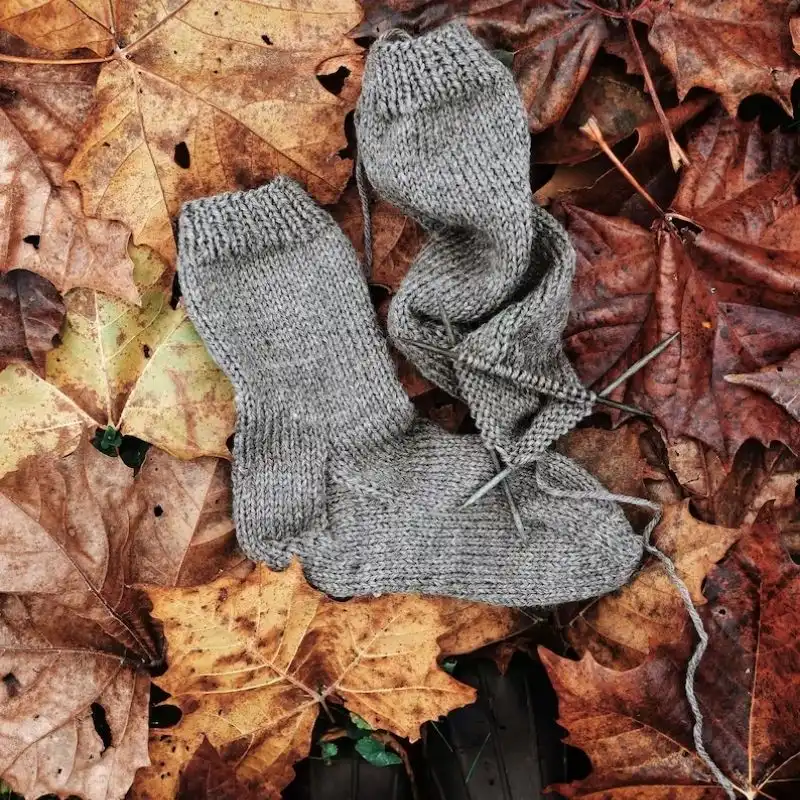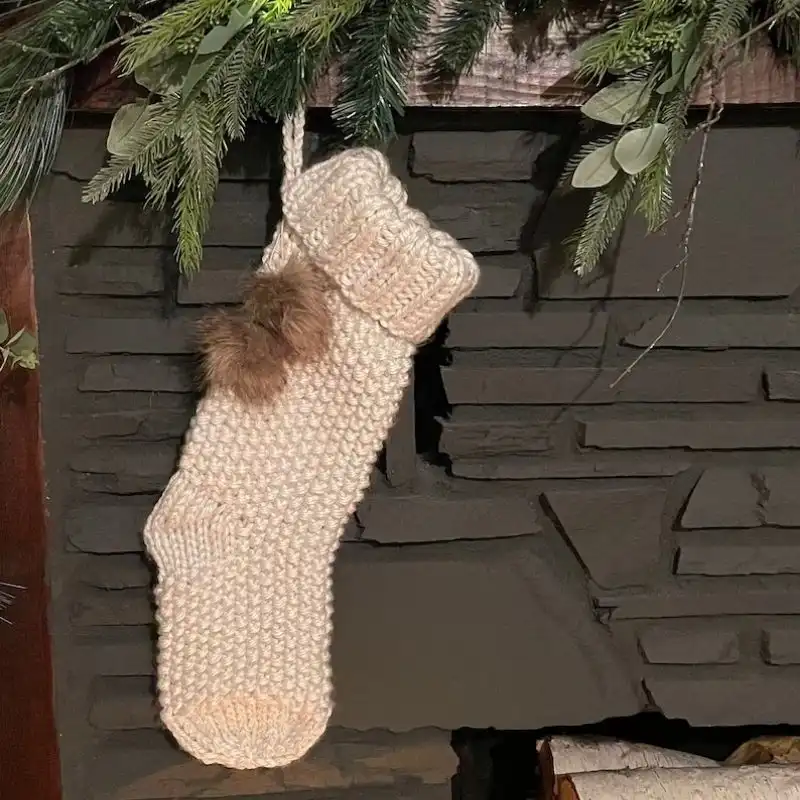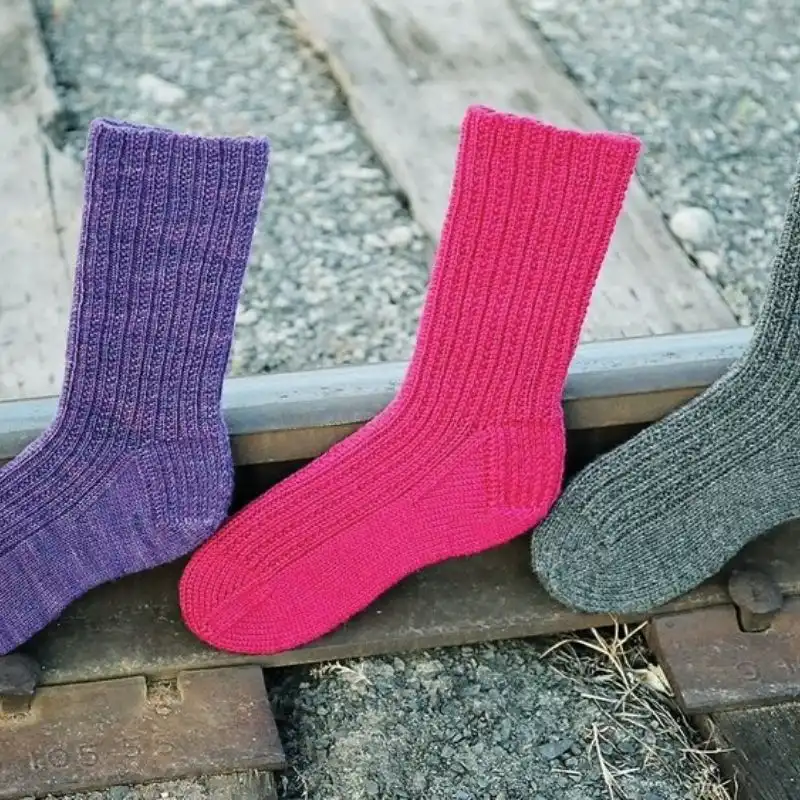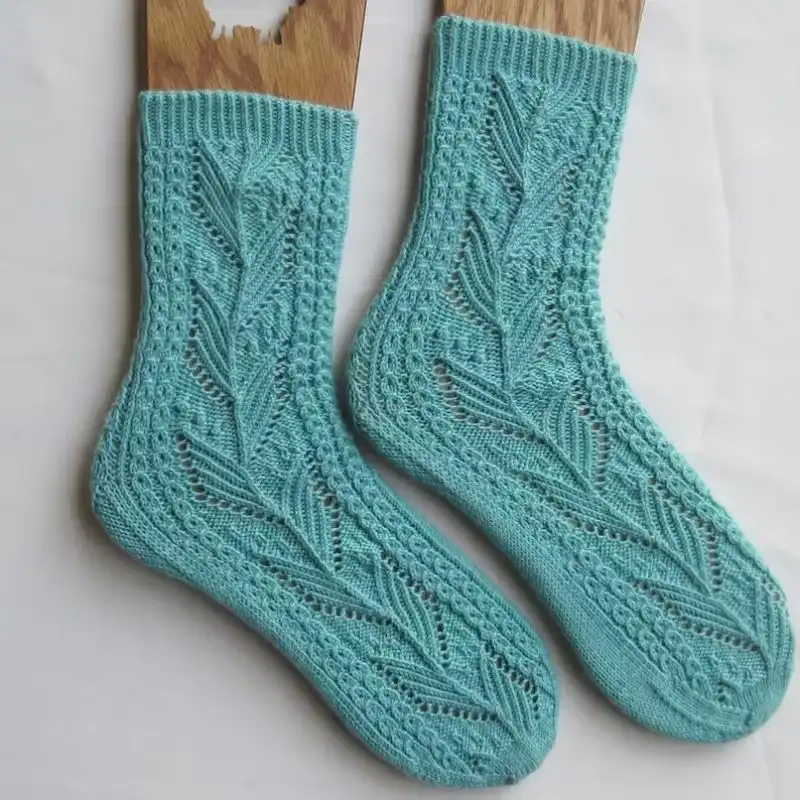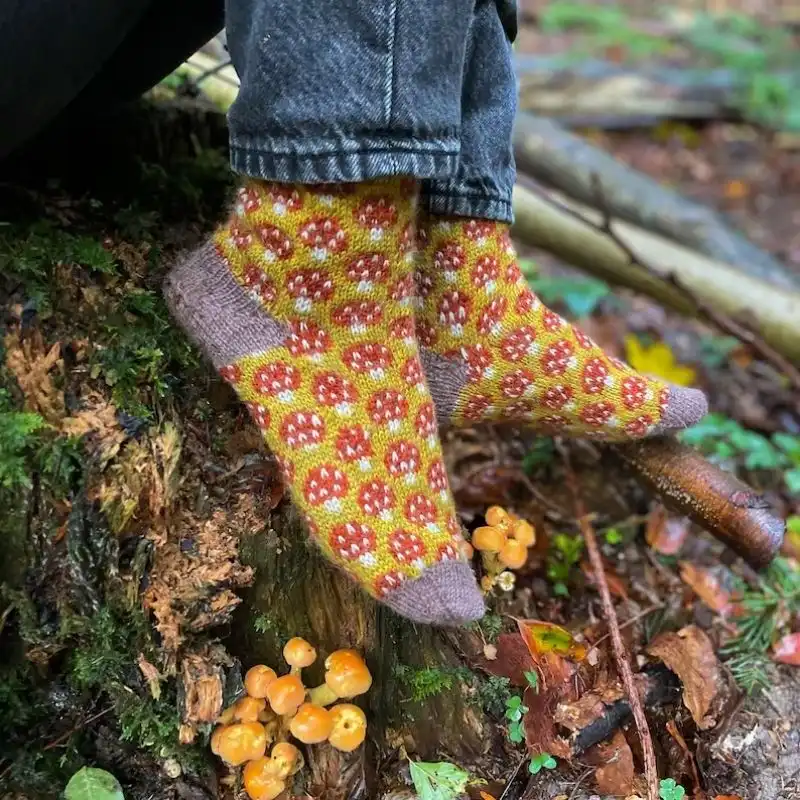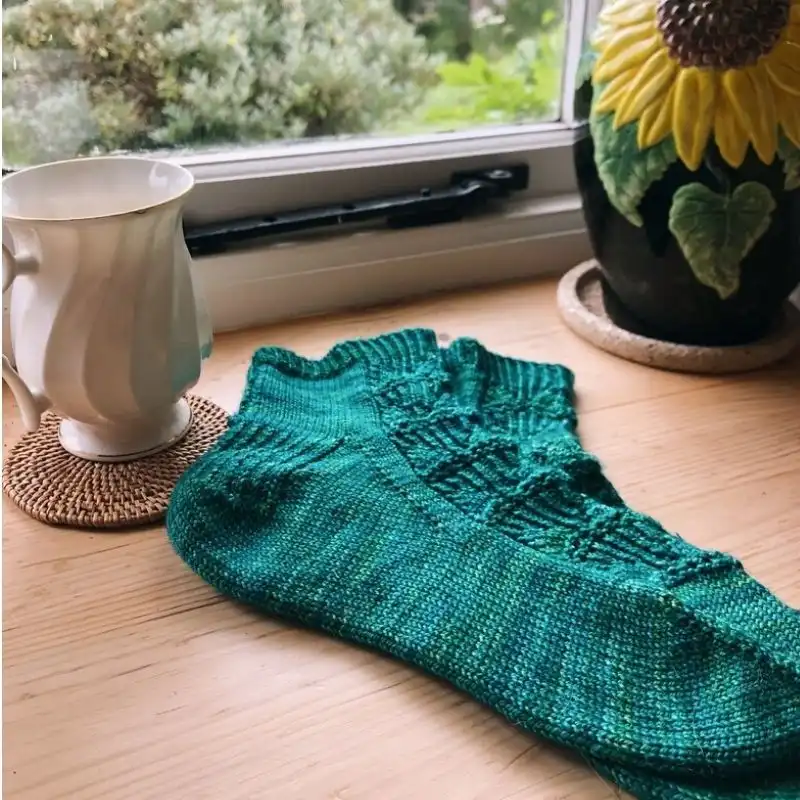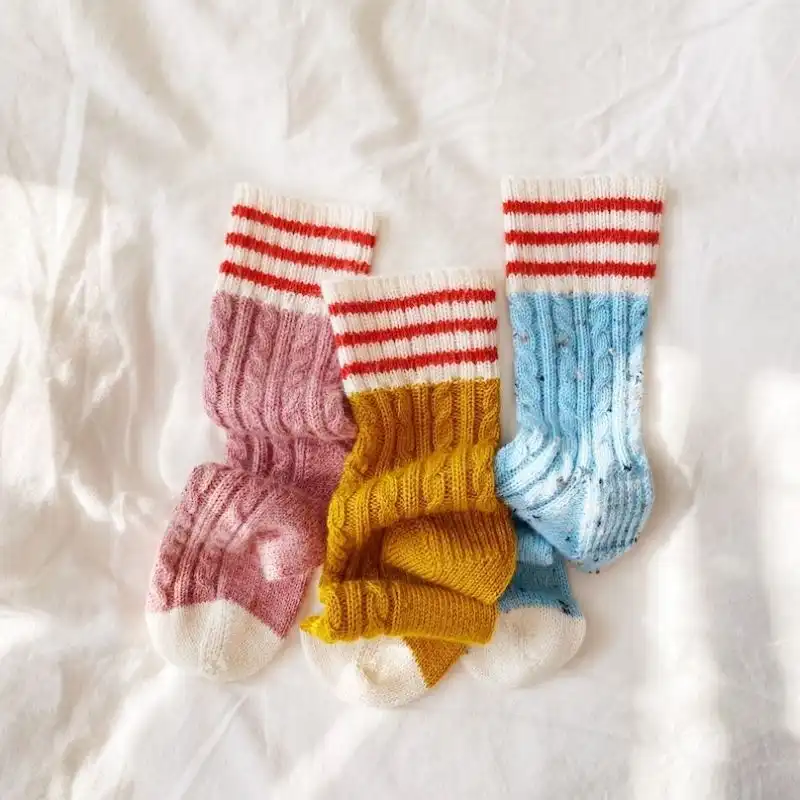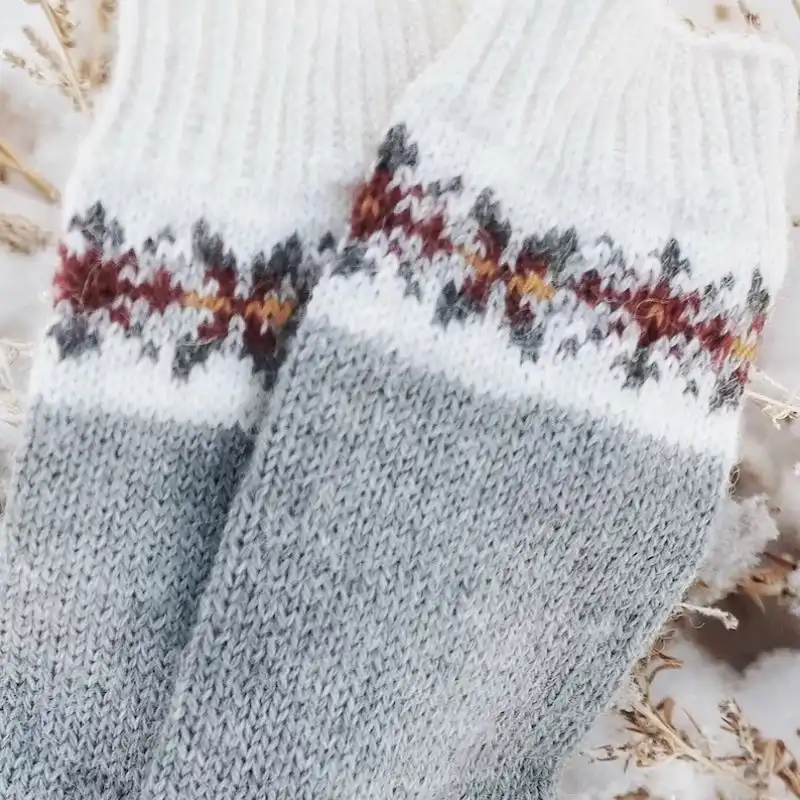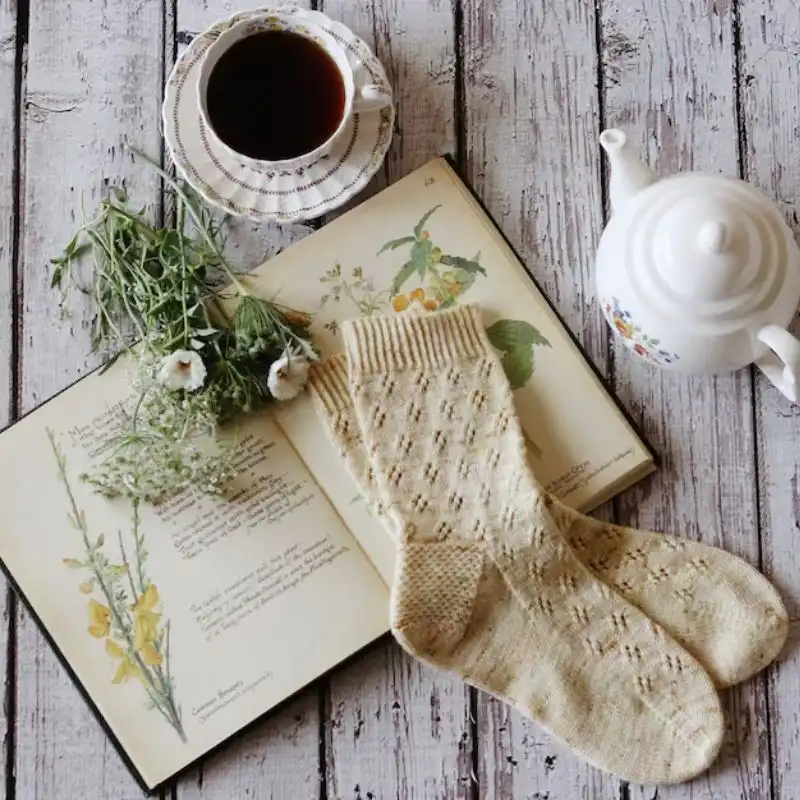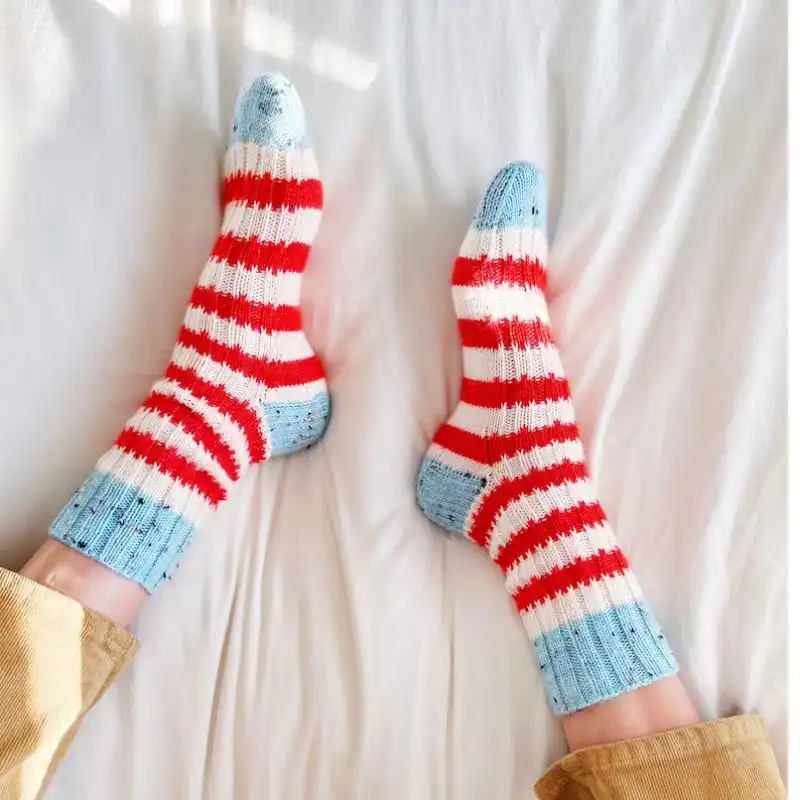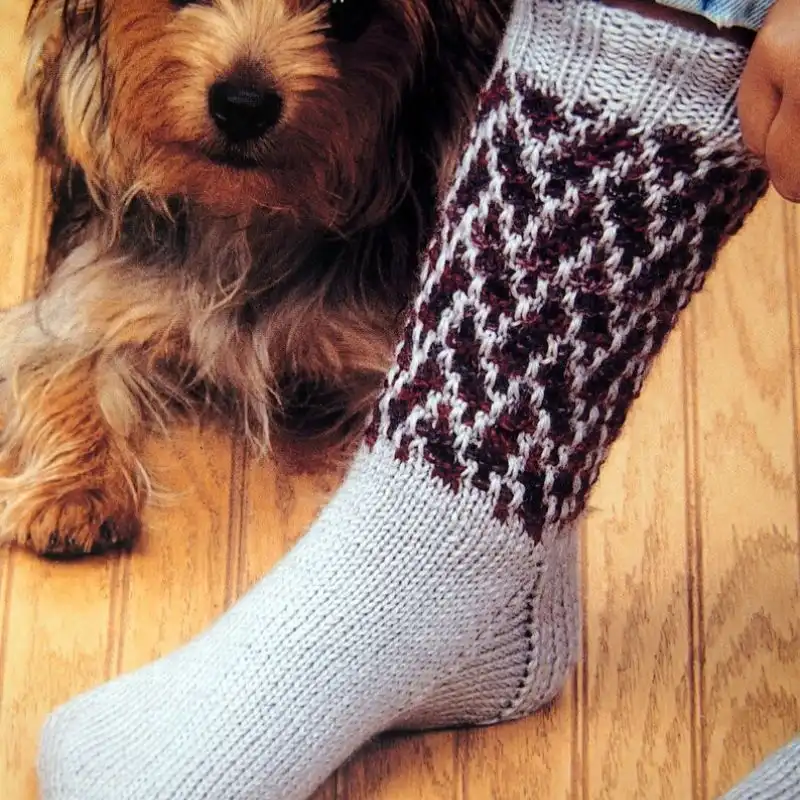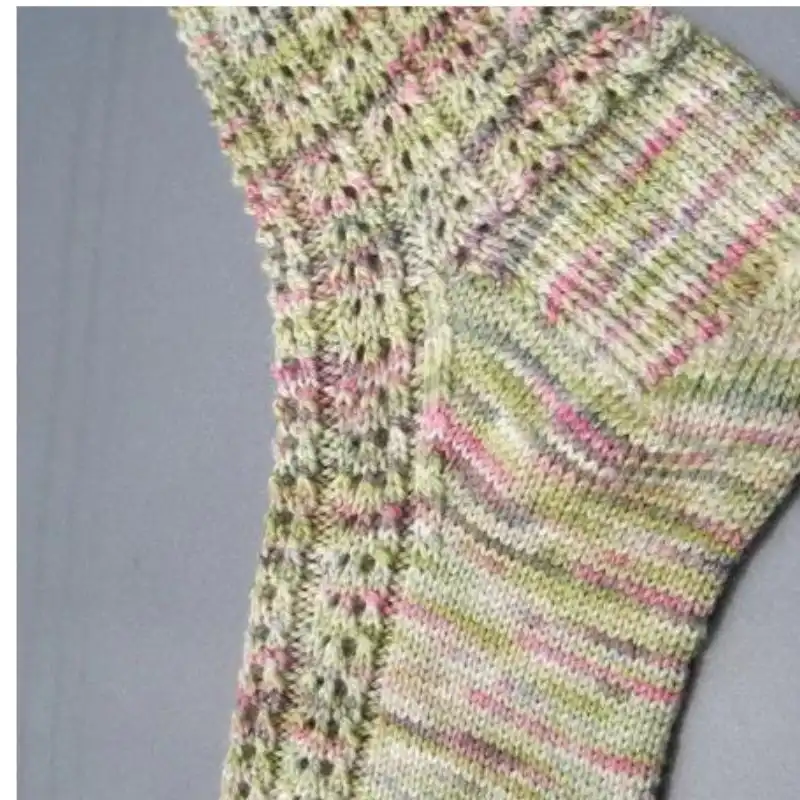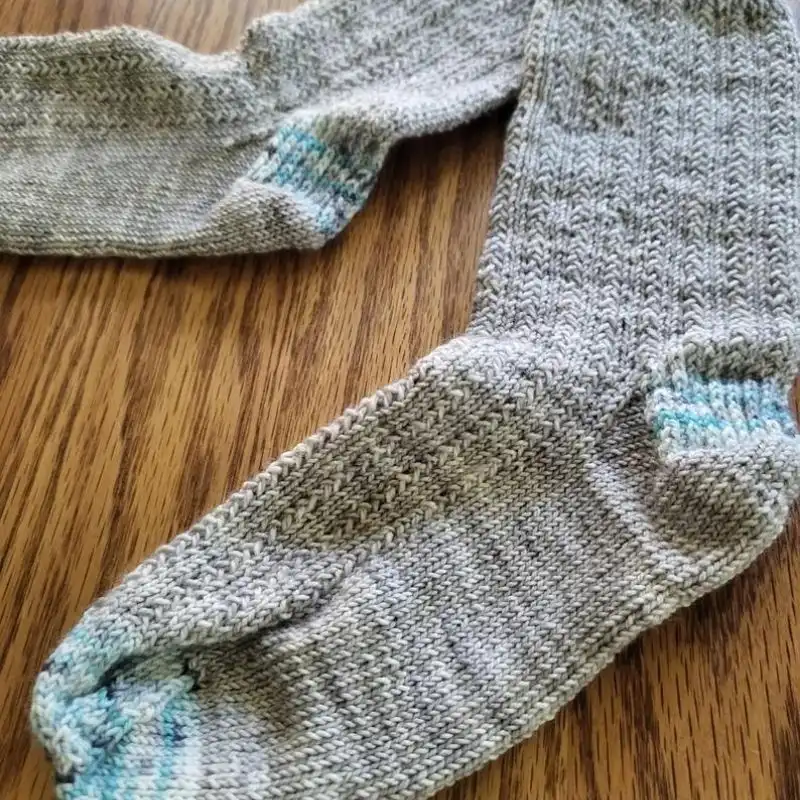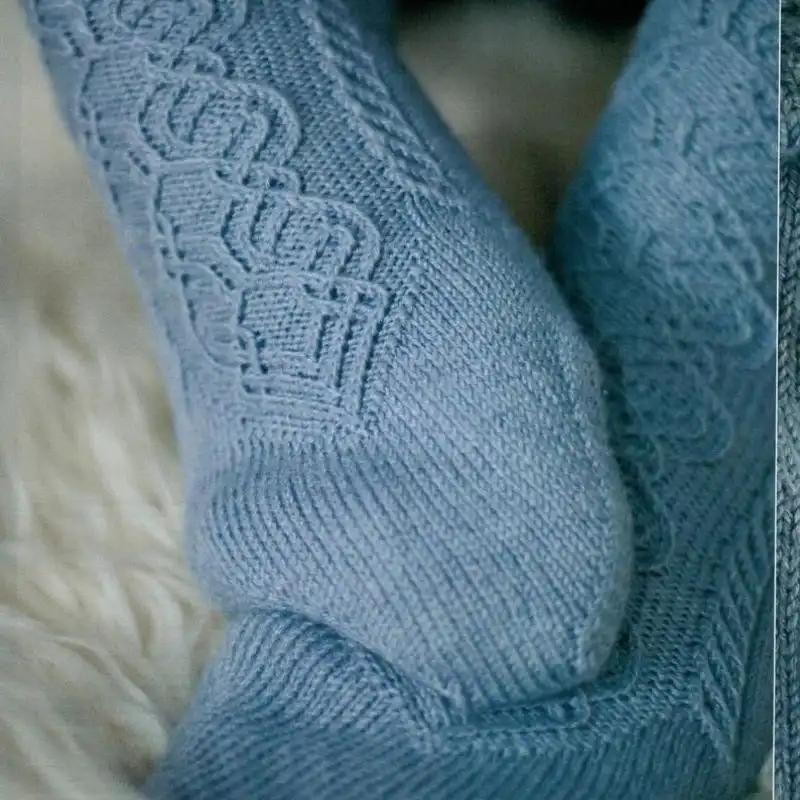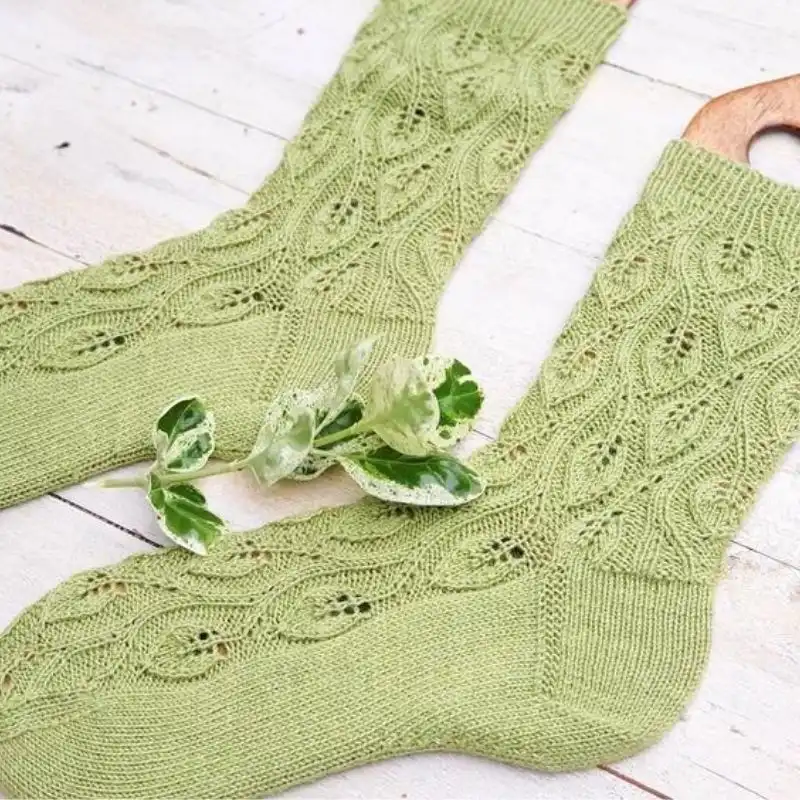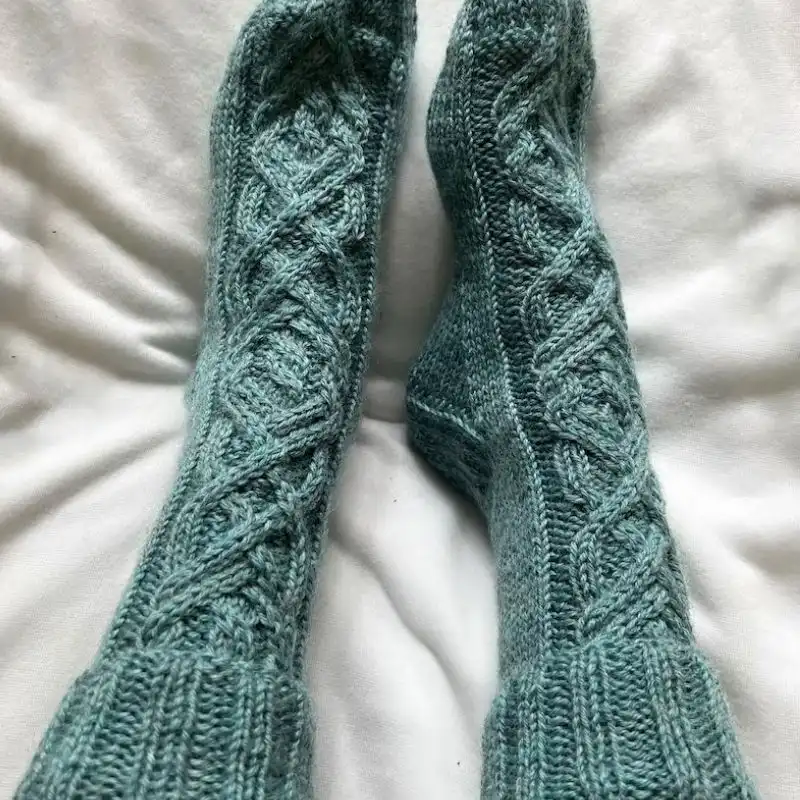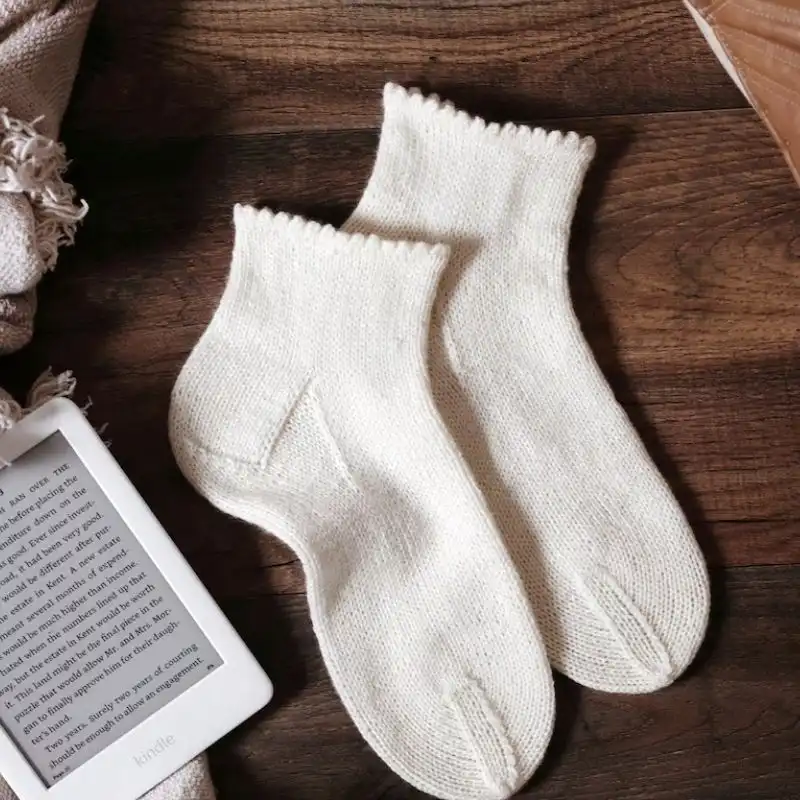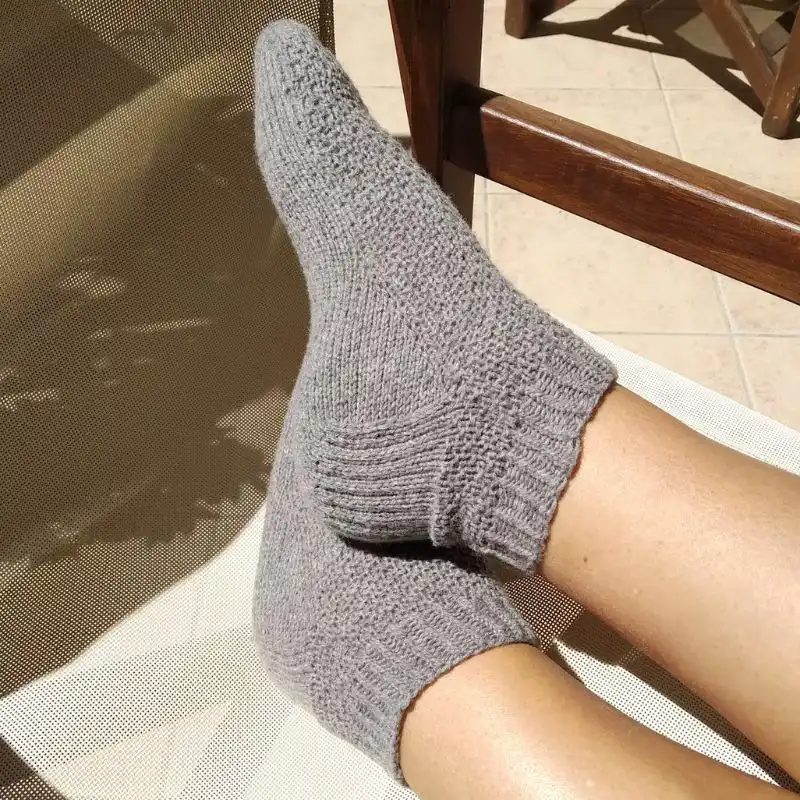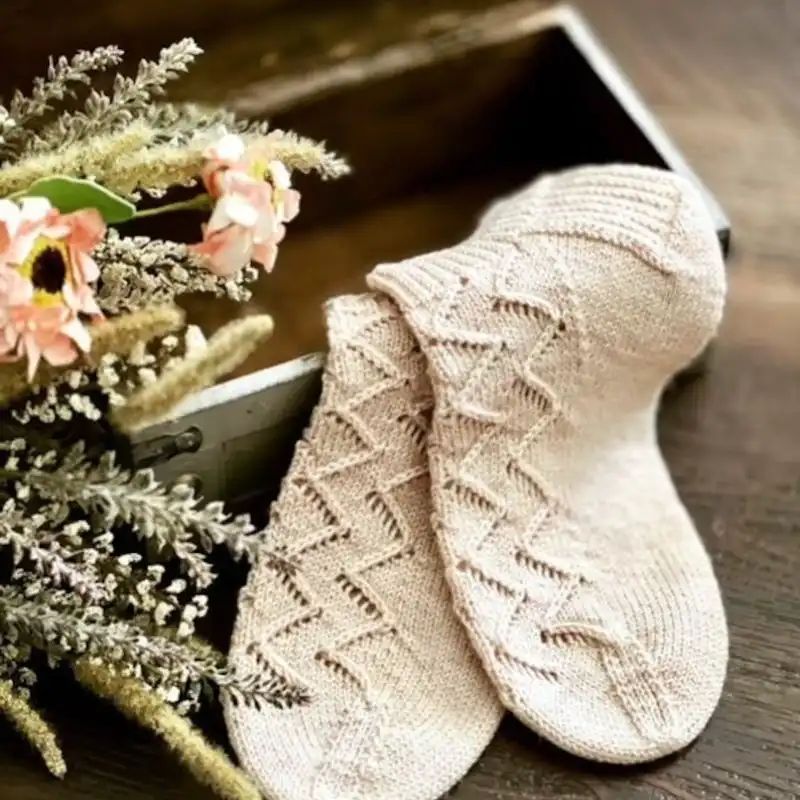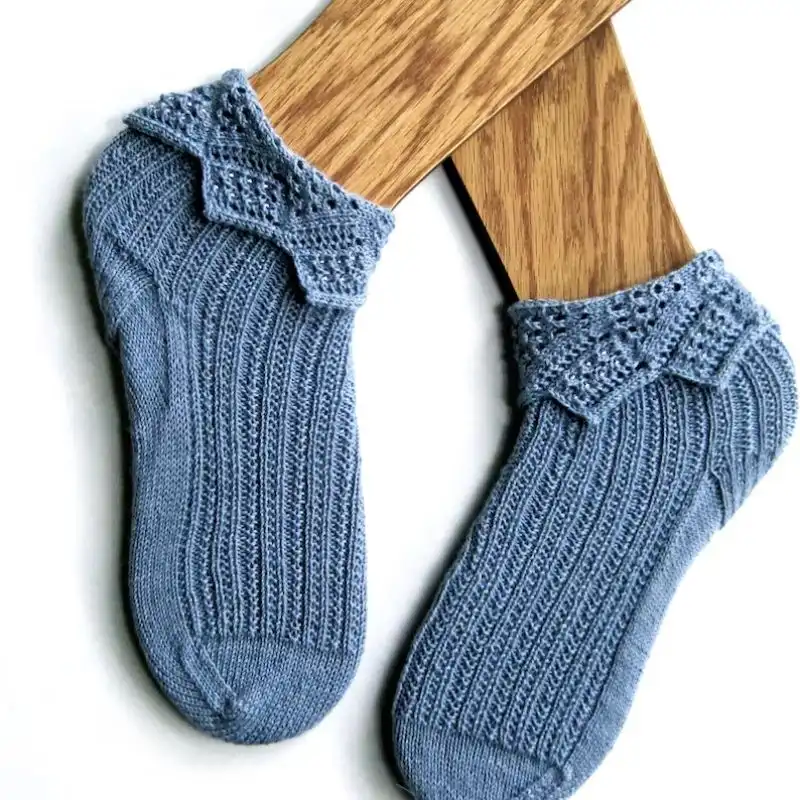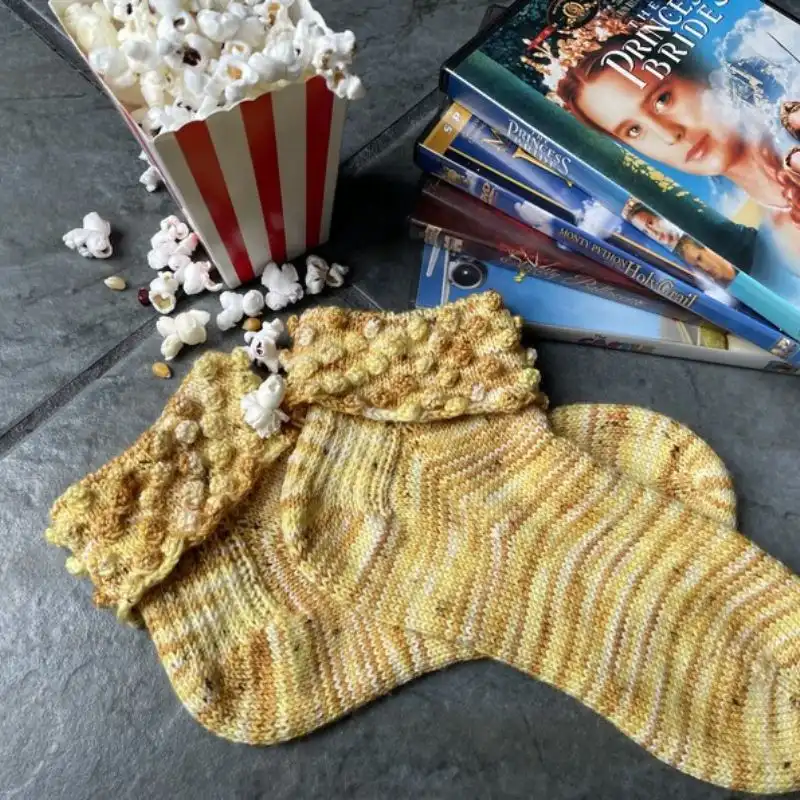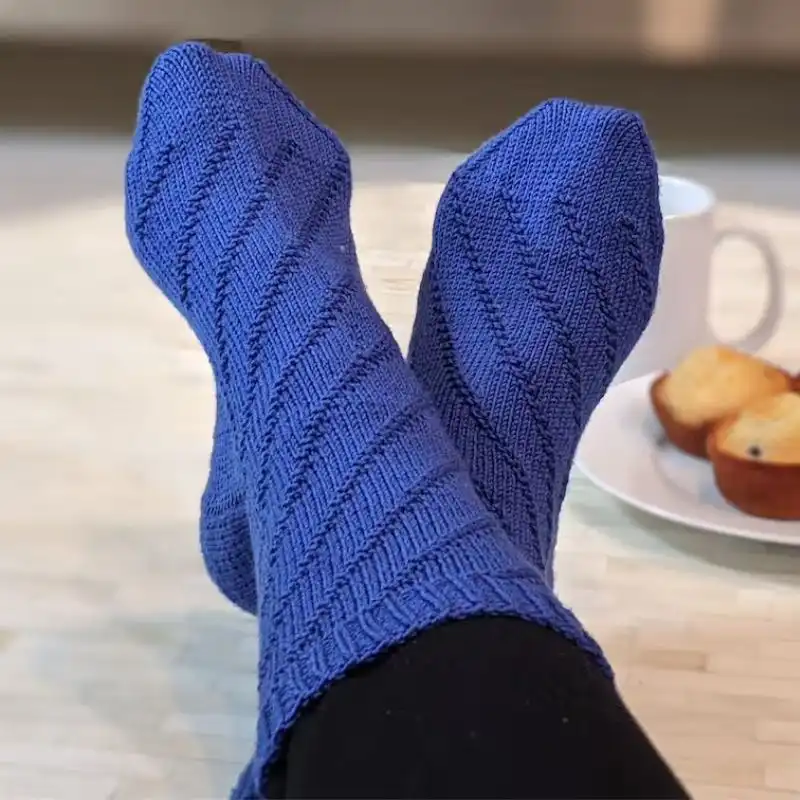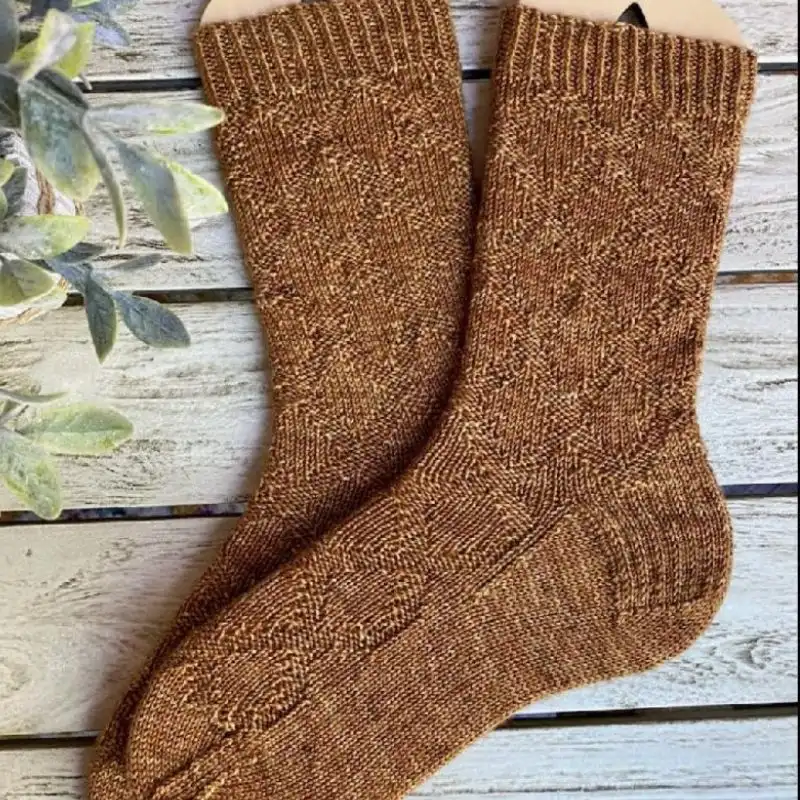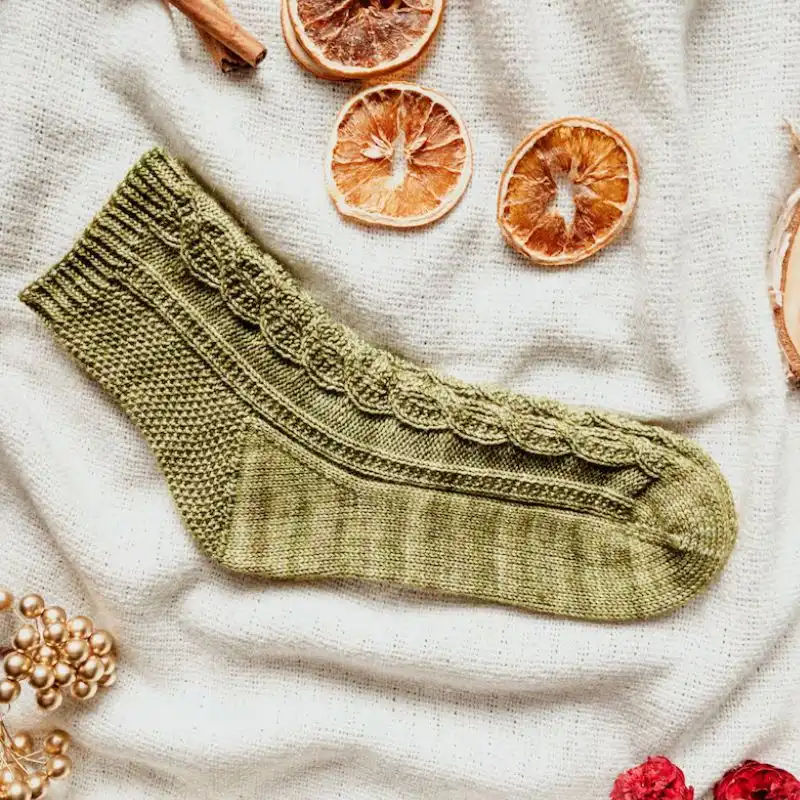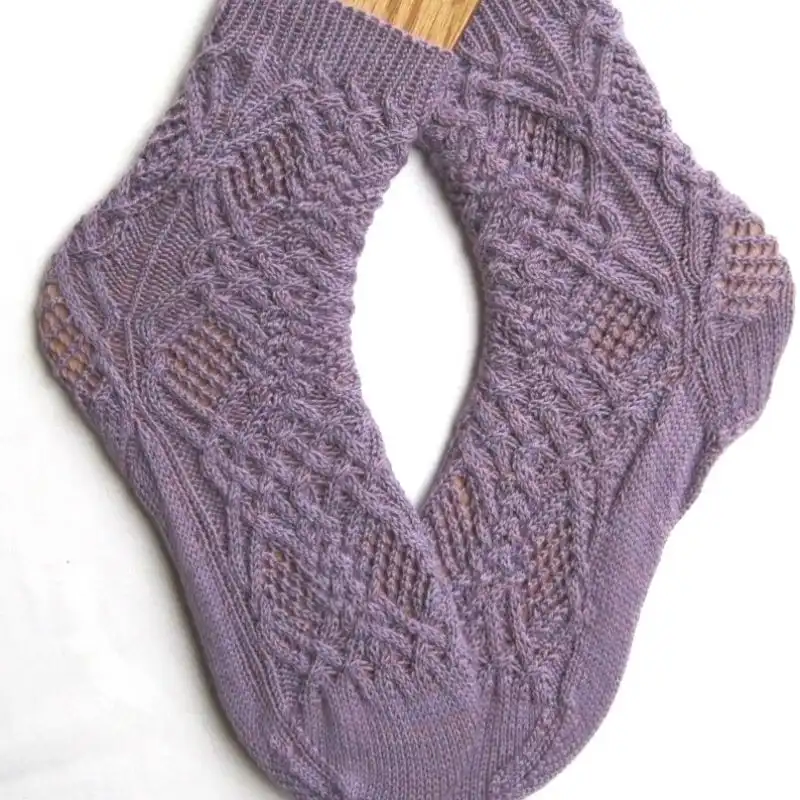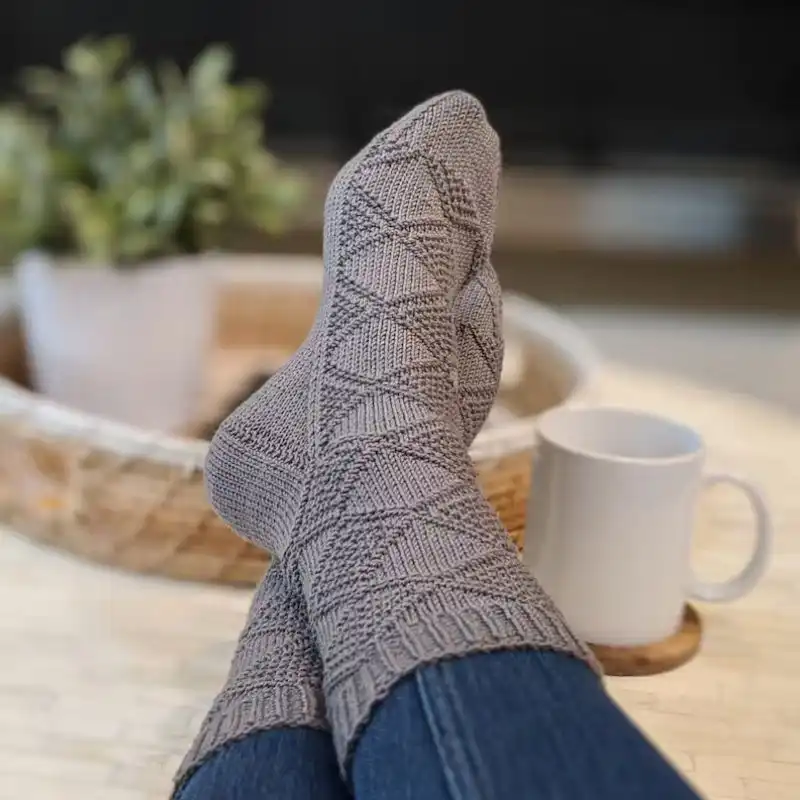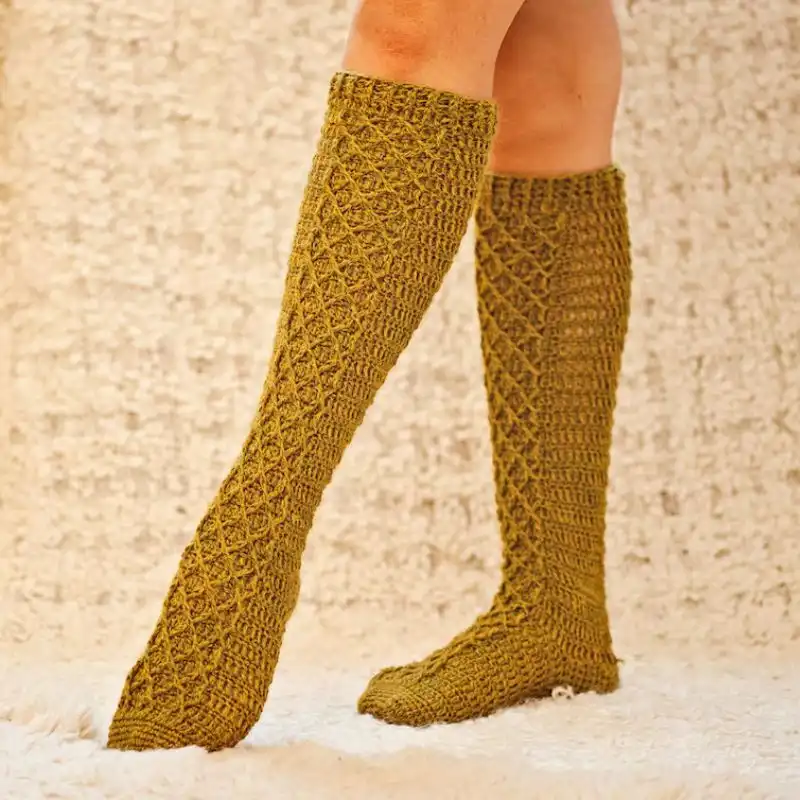Say goodbye to cold feet and welcome to the world of stylish comfort! Embrace the cozy and vibrant realm of sock knitting, a craft that seamlessly blends practicality with the joy of creativity. By knitting your socks, you keep your feet warm and express your unique style through intricate patterns and delightful color combinations.

The satisfaction of slipping your feet into warm, custom-made comfort at the end of a long day is a reward. Sock knitting has an enduring appeal, offering a relatively quick project completion compared to larger knits while providing ample space for endless creativity.
In the world of sock knitting, you have many options—various patterns, techniques, yarns, and colors—to choose from, making it a delightful space for both seasoned knitters and beginners venturing into the world of yarn and needles. Crafting your socks is an exploration filled with delightful discoveries and the pure joy of creation.
Benefits Of Knitting Socks
- Customization: When you knit your socks, you can choose the exact colors, patterns, and yarns that resonate with your unique style and personality. It’s a beautiful way to express your individuality through your crafted creations.
- Perfect Fit: Knitting socks provides the incredible benefit of tailoring the size and fit to your needs. Achieving a perfect fit for your feet ensures a level of comfort that’s hard to attain with store-bought socks.
- Quality: Homemade knitted socks boast superior quality compared to many store-bought alternatives. Crafted with care, they are durable and can be made using premium yarns, offering enhanced warmth and comfort.
- Therapeutic Benefits: Like other forms of crafting, engaging in sock knitting can be a meditative practice with mental and emotional benefits. It has the potential to reduce stress, improve focus, and instill a sense of accomplishment upon completing a project.
- Practicality: Socks are a practical necessity, and by knitting your own, you ensure a constant supply of fresh, personalized pairs. Additionally, hand-knitted socks make thoughtful and unique gifts for loved ones.
- Skill Building: Knitting socks provides a platform to experiment with various basic and advanced techniques. From different stitch patterns to heel constructions and toe shapes, it’s an excellent way to challenge yourself and enhance your knitting skills.
- Sustainability: Embracing sock knitting aligns with the principles of the slow fashion movement. By creating items that last longer and reducing reliance on mass-produced goods, you contribute to a more sustainable lifestyle.
- Fun: Above all, knitting socks is a joyful and satisfying experience. Witnessing a skein of yarn transform into a beautiful, functional item, stitch by stitch, is deeply gratifying. The journey of creating is just as enjoyable as the final product.
Essential Tools & Materials
Glossary Of Sock Knitting Patterns
- k – knit
- p – purl
- yo – yarn over
- k2tog – knit two together
- ssk – slip, slip, knit
- sl – slip a stitch
- PSSO – pass slipped stitch over
- m1 – make one
- m1l – make one left
- m1r – make one right
- cdd – -centered double decrease
- tbl – through back loop
- pm – place marker
- sm – slip marker
- rm – remove marker
- rep – repeat
- sts – stitches
- rnd(s) – round(s)
- dpn – double-pointed needle
- cn – cable needle
RELATED: 25 Knitting Cast-On Methods Dive Into The World Of Crafting
Foot Size Chart For Sock Knitting
Have a look at the detailed foot size chart for sock knitting, focusing on the United States, United Kingdom, and Canada, with various sock sizes:
| Country | Sock Size (US) (Women) | Women’s Foot Length (inches) | Women’s Foot Length (cm) | Sock Size (US) (Men) | Men’s Foot Length (inches) | Men’s Foot Length (cm) |
| United States | 5 – 6 | 8.5 – 8.875 | 21.6 – 22.5 | 6 – 7.5 | 9.5 – 9.875 | 24.1 – 25.1 |
| 6.5 – 7 | 9 – 9.25 | 22.9 – 23.5 | 8 – 8.5 | 10 – 10.375 | 25.4 – 26.4 | |
| 7.5 – 8 | 9.375 – 9.625 | 23.8 – 24.4 | 9 – 9.5 | 10.5 – 10.875 | 26.7 – 27.6 | |
| 8.5 – 9 | 9.75 – 10 | 24.8 – 25.4 | 10 – 10.5 | 11 – 11.375 | 27.9 – 28.9 | |
| 9.5 – 10 | 10.125 – 10.25 | 25.7 – 26 | 11 – 11.5 | 11.5 – 11.875 | 29.2 – 30.2 | |
| 10.5 – 11 | 10.375 – 10.5 | 26.4 – 26.7 | 12 – 12.5 | 12 – 12.375 | 30.5 – 31.4 | |
| 11.5 – 12 | 10.625 – 10.75 | 27 – 27.3 | 13 – 13.5 | 12.5 – 12.875 | 31.8 – 32.7 | |
| United Kingdom | 2.5 – 3 | 6 – 6.125 | 15.2 – 15.6 | 3.5 – 4 | 6.5 – 6.875 | 16.5 – 17.5 |
| 3.5 – 4 | 6.25 – 6.5 | 15.9 – 16.5 | 4.5 – 5 | 7 – 7.375 | 17.8 – 18.7 | |
| 4.5 – 5 | 6.625 – 6.75 | 16.8 – 17.1 | 5.5 – 6 | 7.5 – 7.875 | 19.1 – 20 | |
| 5.5 – 6 | 6.875 – 7 | 17.5 – 17.8 | 6.5 – 7 | 8 – 8.375 | 20.3 – 21.3 | |
| 6.5 – 7 | 7.125 – 7.25 | 18.1 – 18.4 | 7.5 – 8 | 8.5 – 8.875 | 21.6 – 22.5 | |
| 7.5 – 8 | 7.375 – 7.5 | 18.7 – 19.1 | 8.5 – 9 | 9 – 9.375 | 22.9 – 23.8 | |
| 8.5 – 9 | 7.625 – 7.75 | 19.4 – 19.7 | 9.5 – 10 | 9.5 – 9.875 | 24.1 – 25.1 | |
| Canada | 5.5 – 6.5 | 8 – 8.375 | 20.3 – 21.3 | 6 – 7 | 8.5 – 8.875 | 21.6 – 22.5 |
| 7 – 8 | 8.5 – 8.875 | 21.6 – 22.5 | 7.5 – 8.5 | 9 – 9.375 | 22.9 – 23.8 | |
| 8.5 – 9.5 | 9 – 9.375 | 22.9 – 23.8 | 9 – 10 | 9.5 – 9.875 | 24.1 – 25.1 | |
| 10 – 11 | 9.5 – 9.875 | 24.1 – 25.1 | 10.5 – 11.5 | 10 – 10.375 | 25.4 – 26.4 | |
| 11.5 – 12.5 | 10 – 10.375 | 25.4 – 26.4 | 12 – 13 | 10.5 – 10.875 | 26.7 – 27.6 | |
| 13 – 14 | 10.5 – 10.875 | 26.7 – 27.6 | 13.5 – 14.5 | 11 – 11.375 | 27.9 – 28.9 |
These approximate measurements may vary slightly between different sock size charts and brands. It’s always recommended to measure the foot and refer to specific size charts provided by the sock pattern or yarn manufacturer for accurate sizing.
Which Is The Best Yarn To Knit Socks?
When choosing the best yarn for knitting socks, you’ll want to look for a blend that combines durability and comfort. A popular choice is a blend of wool and nylon, usually about 75% wool and 25% nylon.
The wool provides warmth and breathability, while the nylon adds durability and elasticity, ensuring your socks withstand frequent wear and washing. Fingering or sport weight is often used for socks, as it balances fine detail and reasonable knitting time.
Also, considering the sock’s intended use can guide your yarn choice. For example, a thicker, more robust yarn might be appropriate if you’re knitting socks for hiking. Meanwhile, a softer and more luxurious yarn, such as a cashmere blend, could be ideal for bed socks.
How Much Yarn Do I Need To Knit Socks?
The amount of yarn needed to knit a pair of socks depends on several factors, including the sock size, the yarn weight, and the pattern complexity.
However, as a general rule of thumb, for an average-sized adult pair of socks (US size 8-10) knitted in fingering weight yarn, you will need approximately 350-400 yards (320-365 meters).
You’ll need considerably less for smaller sizes, such as children’s socks, while for larger or knee-high socks, you’ll need more. Remember, the thickness of the yarn plays a significant role in how much you need.
If you’re knitting with sport or DK weight yarn, you’ll need fewer yards because those yarns are thicker. Always refer to your pattern for specific yardage requirements, as patterns with more intricate designs or thicker cuffs may require additional yarn.
RELATED: The Size Spectrum Exploring Knitting Needle Sizes For Every Project
Techniques & Stitches For Knitting Socks
Knitting socks can involve various techniques and stitches, depending on the complexity of the design. Here are some of the essentials you’ll need to familiarize yourself with:
- Knitting In The Round: Socks are typically knitted in the round to create a seamless tube. You may use double-pointed needles, two circular needles, or one long circular needle for the magic loop technique.
- Casting On: A variety of cast-on methods are available for socks. The long tail cast-on is quite common, but you might use a technique like Judy’s Magic Cast-On for toe-up socks.
- Knit And Purl Stitches: These are the essential knitting stitches used in most sock patterns.
- Decreases (K2tog & SSK): These techniques help to shape the toe and often the gusset of the sock.
- Increases (M1L & M1R): Increases are typically used in the gusset of a top-down sock or the toe of a toe-up sock.
- Short Rows: Many sock patterns use short-row techniques for shaping the heel. The wrap and turn (W&T) is a standard method, though German short rows or the shadow wrap technique can also be used.
- Picking Up Stitches: When turning the heel, you must pick up stitches along the edge of the heel flap.
- Ribbing: A 1×1 or 2×2 rib is commonly used at the cuff of the sock to help keep it snug against your leg.
- Grafting (Kitchener Stitch): This technique is often used to close the toe of a cuff-down sock, creating a seamless finish.
Can A Beginner Knit Socks?
Knitting socks is often seen as an intermediate-level knitting project due to the techniques involved, such as knitting in the round, turning a heel, and shaping a toe, which can be challenging for beginners.
Socks are typically knitted on a small number of stitches, which can require more precision and patience than larger, less intricate projects. That being said, a motivated beginner can knit socks. It might be a bit more of a challenge, but it can also be a great way to learn new skills.
The key is to start with a simple pattern. Many beginners find that knitting a sock with a worsted weight yarn is a good starting point before moving on to the more common fingering weight socks. The thicker yarn knits faster, making it easier to see and understand the construction.
Advantage & Technique For Toe-Up Sock Knitting
Toe-up sock knitting is a method where the sock is started from the toe and worked up towards the cuff. It has several advantages and incorporates specific techniques. Here they are:
Advantages
- Perfect Fit: Toe-up knitting allows you to try on the sock as you knit, ensuring a perfect fit, especially in the foot and leg length.
- Yarn Optimization: With this method, you can use up almost all of your yarn without fear of running out before you complete your pair, as you can begin your ribbed cuff when you’ve reached the halfway point of your yarn.
- Avoiding Kitchener Stitch: Some knitters find grafting the toe (often done with the Kitchener stitch in cuff-down socks) tricky, and toe-up socks eliminate this step as the toes are usually closed with a simple cast-on method.
Techniques
- Judy’s Magic Cast-On: This is a popular method for starting toe-up socks. It creates a seamless and tight start.
- Short-Row Toes: This technique involves using wrap-and-turns to create the shape of the toe.
- Wrap And Turn (W&T) or German Short Rows: These methods are commonly used to shape the heel of a toe-up sock.
- Gusset Increases: Unlike cuff-down socks, where decreases shape the gusset, toe-up socks require increases to form the gusset.
- Stretchy Bind-Off Methods: Since you’ll be binding off at the cuff, which needs to stretch over the foot, methods such as Jeny’s Surprisingly Stretchy Bind-Off (JSSBO) or the Russian bind-off are often recommended for toe-up socks.
How Many Stitches Required To Cast On For Knitting Socks?
The method you use to cast on for knitting socks and the number of stitches you cast on largely depends on the style of sock knitting (toe-up or cuff-down) and the size of the sock you’re knitting.
For Cuff-Down Socks
- Casting On: Start by casting on the required number of stitches for the cuff. The long tail cast-on is a popular method as it’s pretty stretchy, making slipping the sock over your foot easier.
- Number Of Stitches: This varies based on the size of the sock and the pattern you’re using. As a general guide, for an average adult sock knitted with fingering weight yarn, you might cast on 64 stitches. For a child’s sock, you might only need 44 stitches.
Always check your pattern for specific casts on counts, as they can significantly vary based on the intended fit and design of the sock.
For Toe-Up Socks
- Casting On: For toe-up socks, you will start by casting on several stitches and increasing the entire foot width as you work the toe. Judy’s Magic Cast-On is a popular method for starting toe-up socks, creating a seamless toe.
- Number Of Stitches: You’ll start with a small number of stitches (often 8-12 stitches per needle), then increase until you have the full number of stitches for the foot. Once the toe increases are complete, the total number of stitches should be the same as for cuff-down socks.
So, you’ll increase for an average adult sock until you have 64 stitches (or according to your pattern).
How To Knit Beginner-Friendly Socks?
Skill Level
Easy
Materials
- Worsted weight yarn (about 200-250 yards)
- Set of US size 5 (3.75mm) double-pointed needles
- Stitch markers
- Yarn needle
Gauge: 20 stitches and 28 rows = 4 inches in stockinette stitch
Instructions
Cast On
Using your preferred method, cast on 40 stitches. Divide the stitches evenly between three double-pointed needles (15 stitches on two needles, 10 stitches on one).
Cuff
- Join to knit in the round, careful not to twist your stitches.
- Knit 2, Purl 2 in a rib pattern for the cuff about 1.5 inches to 2 inches.
Leg
Continue in the round, knitting every stitch until the leg measures about 5 inches or your desired length.
Heel Flap
Divide The Stitches so half is on one needle (20 stitches) for the heel flap.
Work The Heel Flap in a slip-stitch pattern:
- Row 1 (Right Side): Slip 1, knit 1, repeat across.
- Row 2 (Wrong Side): Purl all stitches.
- Repeat these two rows for about 20 or until the heel flap is square.
Turn Heel
- Setup Row (Right Side): Knit 11, ssk, knit 1, turn.
- Row 1 (Wrong Side): Slip 1, purl 5, p2tog, purl 1, turn.
- Row 2 (Right Side): Slip 1, knit to one stitch before the gap, ssk (slip, slip, knit), knit 1, turn.
- Repeat Rows 1 and 2 until all stitches are used, ending with a wrong-side row.
Gusset
- Pick up stitches along the side of the heel flap (about 10 stitches).
- Knit across the instep stitches.
- Pick up stitches along the other side of the heel flap (about 10 stitches).
- Knit half of the heel stitches.
- Place a marker for the new beginning of the round.
Decrease For Gusset
- Round 1: Knit to 3 stitches before the instep, k2tog, knit 1, knit the instep stitches, knit 1, ssk, knit to the end.
- Round 2: Knit all stitches.
- Repeat Rounds 1 and 2 until you have your original stitch count (40 stitches).
Foot
Continue knitting in the round until the foot measures about 1.5 inches less than the total desired length.
Toe
- Round 1: Knit to 3 stitches before the end of the first needle, k2tog, knit 1; knit the instep stitches; knit 1, ssk, knit to the end of the round.
- Round 2: Knit all stitches.
- Repeat these two rounds until you have about 20 stitches remaining.
Finishing
- Graft the toe stitches together using the Kitchener stitch.
- Weave in all ends.
35 Different Sock Knitting Patterns
Discover a world of creativity with different sock knitting patterns. From cozy cables to elegant lace, explore Fair Isle colorwork, classic ribbing, and textured tweed designs. Dive into entrelac adventures, slip-stitch marvels, bold chevrons, basketweave wonders, and embrace the simplicity of seed stitch for truly unique and stylish handmade socks.
7 Beginner Friendly Patterns
1. Classic Ribbed Socks
Classic Ribbed Socks are a staple in sock knitting. They feature a timeless ribbed pattern that creates a snug and stretchy fabric. The ribbing is typically worked throughout the sock, providing a comfortable fit and excellent elasticity. Classic Ribbed Socks are perfect for casual and dressy occasions, making them a versatile and essential addition to any sock drawer.
Suggested Yarn: Merino Wool Blend
Difficulty Level: Intermediate
Yarn Weight: Fingering
Crochet Hook: 2.25mm
2. Simple Stockinette Socks
The simplest and most common sock pattern, these socks are worked entirely in stockinette stitch, which means knitting every round. They have a smooth, uniform appearance and are great for showcasing variegated or self-striping yarn.
3. Seed Stitch Socks
Seed Stitch Socks showcase the beautiful texture of the seed stitch pattern. This stitch involves alternating knit and purl stitches to create a fabric with a bumpy, textured appearance. Seed Stitch Socks offer a simple yet elegant design that works well with solid or variegated yarns. The seed stitch adds visual interest and a cozy texture to the socks.
4. Railroad Rib Socks
These socks create the look of traditional rib stitches using alternate stitches, such as twisted knit stitches. They give the appearance of ribbing without the need for extensive ribbing techniques.
5. Mock Cable Socks
These socks use twisted stitches to create the illusion of cables, Mimicking the look of intricate cable stitches. They are an excellent option for beginners exploring cable knitting without a cable needle.
6. Lace Cuff Socks
These socks feature a delicate lace pattern at the cuff, adding a touch of elegance and femininity. The lace cuff can be a simple motif or a more intricate design, making these socks visually appealing.
7. Magical Mycelium socks
These socks showcase a Magical Mycelium pattern that creates a unique and visually attractive texture. The pattern adds an element of sophistication to the socks and provides a snug fit.
18 Intermediate Patterns
1. Lace Panel Socks
These socks incorporate delicate lace panels, typically running vertically along the leg or around the ankle. The lace panels create an elegant and airy look, perfect for showcasing intricate lace motifs.
2. Cable-Knit Socks
These socks feature elaborate cable patterns, twists, and crosses of stitches that create textured designs. Cable-knit socks are visually striking and often evoke a cozy and traditional feel.
3. Fair Isle Socks
Fair Isle knitting involves stranded colorwork, where multiple colors are used in each row to create intricate patterns and motifs. Fair Isle socks showcase beautiful color combinations and intricate designs, making them visually captivating.
4. Colorblock Socks
Colorblock socks use blocks of different colors to create a bold and modern look. The color transitions can be clean, geometric, or blended for a more subtle effect, allowing for endless customization.
5. Chevron Pattern Socks
Chevron pattern socks showcase zigzagging lines that create a dynamic and energetic design. You can achieve the chevron motif through simple increases and decreases, resulting in visually cute socks.
6. Honeycomb Socks
Honeycomb socks feature a textured stitch pattern that resembles the cells of a honeycomb. The stitch pattern creates a visually exciting and cozy texture, perfect for keeping feet warm and stylish.
7. Slip Stitch Socks
Slip Stitch Socks utilize the slip stitch technique to create stunning colorwork effects without stranding or carrying multiple yarns. Slipping stitches and working with one color simultaneously achieve intricate patterns and designs. Slip Stitch Socks allow you to experiment with color combinations and produce eye-catching socks with intricate colorwork.
8. Waffle Stitch Socks
Waffle stitch socks display a textured pattern resembling the squares of a waffle. This stitch pattern creates a cozy and cushioned fabric, making these socks visually appealing and comfortable.
9. Basketweave Socks
Basketweave socks feature a stitch pattern that mimics the interwoven strands of a basket. The textured design adds depth and interest to the socks, giving them a unique and sophisticated look.
10. Fisherman’s Rib Socks
Fisherman’s rib stitch creates a dense and stretchy fabric similar to that used in traditional fisherman’s sweaters. Fisherman’s rib socks provide extra warmth and elasticity, making them ideal for colder climates.
11. Eyelet Rib Socks
These socks combine ribbing with eyelet or lace patterns, creating a delicate and feminine design. The eyelet details add visual interest to the ribbed fabric, resulting in stylish and breathable socks.
12. Herringbone Socks
Herringbone socks showcase a distinctive V-shaped pattern resembling the bones of a herring. This stitch pattern creates a sophisticated and timeless design, adding a touch of elegance to the socks.
Suggested Yarn: Merino Wool Blend
Difficulty Level: Intermediate
Yarn Weight: Fingering
Crochet Hook: 2.75mm
13. Twisted Stitch Socks
Twisted socks feature stitches twisted to the right or left, creating intricate cable-like patterns. These socks display complex textures and are perfect for showcasing intricate stitch work.
14. Leaf Pattern Socks
Leaf pattern socks incorporate stitch patterns that resemble leaves, adding a natural and organic touch. The leaf motifs can be delicate or bold, creating beautiful designs inspired by nature.
15. Wateree Socks
The Wateree Socks knitting pattern offers a delightful project for sock enthusiasts. With its unique blend of cables, lace, and textured stitches, these socks provide a captivating knitting experience. Elevate your sock collection with the charm of Wateree, creating a cozy and stylish accessory for any occasion.
16. Ruffle Cuff Socks
Ruffle Cuff Socks feature a unique and decorative ruffle detail at the cuff, adding a feminine and playful touch to the socks. The ruffle is typically created by increasing stitches and incorporating lace or frilled patterns. These socks are a fun and stylish accessory, perfect for adding a touch of flair to any outfit.
17. Feather And Fan Socks
Feather and Fan Socks feature the famous feather and fan lace pattern, known for its undulating waves and delicate texture. The lace motifs create a beautiful, airy fabric that adds a touch of elegance to the socks. Knitting Feather and Fan Socks requires intermediate lace knitting skills and yields socks with a graceful and feminine appearance.
17. Lace And Seed Stitch Socks
Lace and Seed Stitch Socks combine the delicate beauty of lace stitches with the subtle texture of seed stitches. The lace motifs add a touch of sophistication, while the seed stitch creates a cozy and textured fabric. These socks offer a harmonious blend of elegance and comfort, making them a pleasure to knit and wear.
18. Zigzag Pattern Socks
Zigzag Pattern Socks showcase a captivating design created by repeating zigzag motifs. The sharp angles and contrasting colors make these socks stand out. Knitting Zigzag Pattern Socks requires attention to stitch count and charted patterns to achieve the desired effect. These socks are great for those looking for a dynamic and visually striking design.
9 Advance Level Patterns
1. Lace And Beads Socks
These socks combine delicate lace patterns with the addition of beads for extra embellishment. The beads are typically threaded onto the yarn and placed strategically within the lace motifs, creating a stunning and intricate design.
2. Lace And Popcorn Stitch Socks
Lace and Popcorn Stitch Socks combine the delicate beauty of lace stitches with the playful texture of popcorn stitches. The socks feature intricate lace motifs interspersed with raised popcorn stitches, creating a visually captivating design. Knitting these socks requires intermediate-level skills in lace knitting and popcorn stitch techniques. The combination of lace and popcorn stitches results in a unique and charming pair of socks that will make a statement.
3. Spiral Rib Socks
Spiral rib socks showcase a unique rib stitch pattern that creates a spiraling effect. The ribbing twists and curves along the sock give it a dynamic and visually exciting appearance. These socks are perfect for those looking for a modern and playful design.
4. Lattice Lace Socks
Lattice Lace Socks feature an intricate lattice-like pattern created with lace stitches. The socks showcase a delicate, airy design that adds elegance to any outfit. The lattice pattern is achieved by combining yarn overs, decreases, and twisted stitches. Knitting these socks requires intermediate-level skills in lace knitting techniques. The result is a pair of beautifully textured, stylish, and eye-catching socks.
5. Textured Bobble Socks
Textured bobble socks feature small, raised bumps or bobbles that add an element of fun and whimsy to the fabric. The bobbles are created by knitting stitches into the same stitch multiple times, creating a three-dimensional texture.
6. Shadow Cable Socks
Shadow cable socks utilize cable stitches to create the illusion of overlapping or shadowed cables. The cables are worked with different stitch sizes or crossed at varying intervals, giving the appearance of depth and complexity.
Suggested Yarn: Merino Wool Blend
Difficulty Level: Advanced
Yarn Weight: Fingering
Crochet Hook: 2.25mm
7. Alpena Cable Lace Socks
These socks combine the elegance of lace panels with the structural beauty of cable stitches. Lace motifs are interspersed with cable patterns, creating a visually captivating and intricate design. These socks offer the best of both worlds for lace and cable enthusiasts.
8. Mock Argyle Socks
Mock argyle socks replicate the look of traditional argyle patterns without the need for complex colorwork. You may achieve the appearance of argyle through stitch patterns, such as slipped or twisted stitches, creating a simplified yet stylish version of the classic design.
9. Embossed Diamond Socks
Embossed diamond socks feature raised diamond patterns that create a textured and visually appealing fabric. The diamonds are created using various stitch techniques, such as twisted stitches or raised increases, resulting in a tactile and luxurious design.
Tips & Tricks For Sock Knitting
Knitting socks can be a rewarding project, but it does have its intricacies. Here are some tips and tricks to help you avoid common mistakes and perfect your sock knitting:
How To Block Knitted Socks?
Blocking is a finishing technique used to refine the shape of knitted items, smooth out any uneven stitches, and give your work a professional finish. Here’s a simple process to block your freshly knitted socks:
- Washing: Start gently washing your socks in cool water with mild soap. Be careful not to agitate the socks too much, which could cause the wool to feel.
- Rinsing: Rinse the soap gently, careful not to wring or twist the socks.
- Removing Excess Water: Lay the wet socks flat on a clean, dry towel and roll them up, pressing gently to squeeze out excess water. Do not wring them out, as it can distort the shape of the socks.
- Shaping and Drying: Unroll the towel and take out the socks. Shape them gently by hand to the correct dimensions. You can use a sock blocker, a foot-shaped tool inserted into each sock. They are typically made of plastic or wood and come in different sizes. If you don’t have a sock blocker, you can create a makeshift one using a hanger bent into the shape of a foot or lay the socks flat and shape them manually.
- Drying: Let the socks dry entirely on the sock blockers or towel. Ensure they are in a well-ventilated area, away from direct sunlight or heat sources.
RELATED: 30 Knit Blanket Patterns For Beginners With Easy And Cozy Designs
Suggestion To Add Personal Touch & Style
Adding personal touches to your knitted socks can turn a simple project into a unique piece of wearable art. Here are some suggestions:
- Play With Color: Experiment with different color combinations or use self-striping or variegated yarn to add a pop of color. You could also try colorwork techniques like Fair Isle to incorporate different colors and patterns.
- Add Texture: Use textured stitches like cables or lace to add visual interest to your socks. Even a simple rib or seed stitch can create a subtle texture.
- Unique Cuffs: Change up the cuff for a different look. Try different ribbing patterns, picot edges, or lacey or cabled cuffs.
- Contrasting Heels And Toes: Knit the heel flap and toe in contrast to the rest of the sock for a fun touch.
- Personalized Stitch Patterns: If you’re confident in your sock construction skills, incorporate stitch patterns with meaning. It could be anything from a loved one’s initials to a motif that represents a favorite hobby or interest.
- Beads Or Sequins: Add beads or sequins to your sock design for a bit of sparkle. Be careful to choose ones that won’t be uncomfortable to wear.
- Adjust The Fit: Customize the fit of your socks by adding ribbing where you need more stretch or using a firmer stitch pattern for areas that need more support.
- Choose Meaningful Yarn: Use a yarn that’s special to you, like a yarn from a local dyer, a handspun yarn, or a yarn in a favorite color or fiber blend.

A Quick Recap
This article delves into the fascinating world of sock knitting – a craft that combines creativity, practicality, and fun. We’ve covered everything from exploring various enticing sock knitting patterns to understanding the essential tools and materials.
We discussed the best yarns for sock knitting, how much you’ll need, and the various techniques and stitches to master. We even discussed the benefits of toe-up sock knitting, how to cast it on, and tips to perfect your sock knitting project.
We also shared an insightful foot size chart to guide you in knitting perfectly fitting socks. We suggest adding your personal touch and style to your knitted socks to make your creations unique.
But reading about it is just half the fun! Now, it’s time to pick up those needles, choose your favorite pattern from our list, and dive into knitting your socks. Remember, every stitch is a step towards creating something warm, cozy, and uniquely you. So, why wait? Start your sock-knitting journey today!
Frequently Asked Questions
Is Sock Knitting Time-Consuming?
Sock knitting can take some time, especially using fine yarn and intricate patterns. However, with practice, you can become faster and more efficient.
Can I Knit Socks With Circular Needles?
Yes, you can use circular needles for sock knitting. Many knitters prefer the “magic loop” method or two circulars for knitting socks.
What’s The Most Difficult Part Of Knitting Socks?
Many knitters find turning the heel the most challenging part of sock knitting. However, with careful attention and practice, it becomes manageable.
How Do I Ensure That My Socks Are The Same Size?
Counting your rounds and keeping track of your progress is crucial. You can also use a row counter or make notes as you work.
What Does ‘Negative Ease’ Mean In Sock Knitting?
Negative ease means the socks are slightly smaller than the actual foot size. It allows the sock to stretch to fit and stay on the foot without being too loose.
Do I Need Special Sock Knitting Patterns For Children Or Babies?
Yes, sock patterns are usually specific to the foot size. Many patterns are available specifically designed for children’s and babies’ sizes.
What Should I Do If I Make A Mistake While Knitting Socks?
Don’t panic! Mistakes happen. Depending on the error, you can unknit (also known as “tinking”), rip back, or use a lifeline to correct it.
- 30 Polo Sweater Knitting Patterns To Keep You Stylish On Every Occasion - January 1, 2024
- 21 Baby Blanket Knitting Kits To Wrap Bundle Of Joy With Love - January 1, 2024
- 15 Cashmere Knitting Kits For Fashionable Knits To Embrace Comfort And Style - January 1, 2024



